NACS State of the Industry data allows retailers and industry suppliers to dig into operational and financial performance metrics based on the geography of their operating areas.
NACS separates the United States into six unique regions, which are based on the fuel PADDs that the U.S. government uses to track fuel movement. These six NACS regions provide geographical groupings of similar states that allow retailers to compare their company’s performance to the companies operating in their geographical region.
Growth-minded companies also use the regional data to help make informed expansion decisions and become familiar with the operational benchmarks of a region.
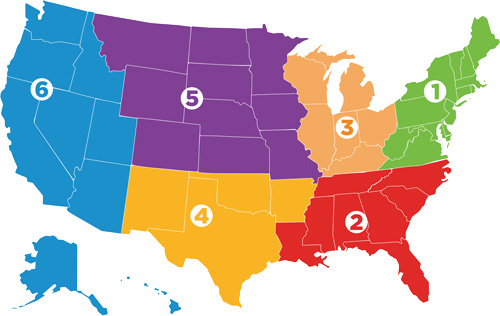
Region 1, Northeast:
high inside sales, mainly driven by foodservice
Region 2, Southeast:
high fuel volume, challenging labor market
Region 3, Midwest:
community-oriented stores, high growth foodservice
Region 4, South Central:
high store counts, competitive market for convenience
Region 5, Central:
lower store density, lower number of transactions
Region 6, West:
high fuel prices, lower inside sales volume
Region 1
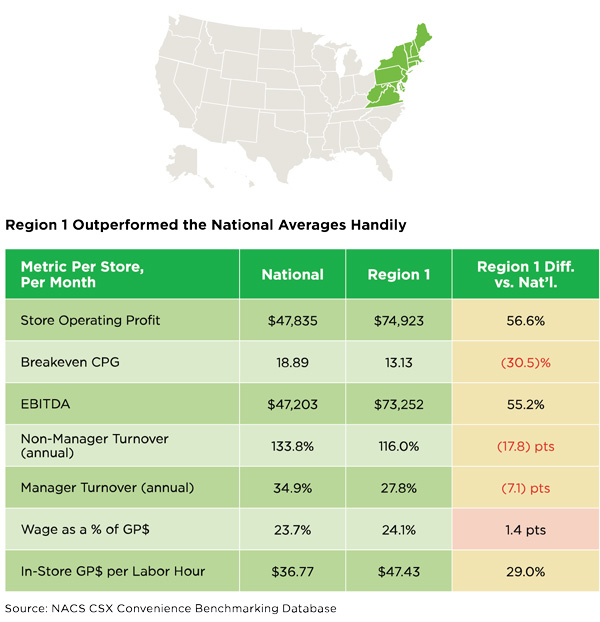
The 14 states in the northeastern U.S. that make up Region 1 contribute 20.5% (30,852 stores) of the total U.S. convenience store universe of 150,174 stores, making this region the second largest in terms of store count.
“Historically, Region 1 financial and operational performance measures are the best of the six regions,” said Brian King, assistant vice president of accounting at Altoona, Pennsylvania-based Sheetz.
The reason is that Region 1 operators have “outstanding in-store performance,” he said, which gives retailers an opportunity to benchmark their inside sales and strategies against these industry-leading operations.
Stacked against the national averages, Region 1 outperformed in all metrics except wages as a percentage of gross profit dollars. Because this region is heavy into foodservice and has areas with higher-than-average salary expectations, the average labor cost per hour was $23.55 in 2022—second to Region 6 (West) at $25-plus per hour.
Average monthly fuel sales outpaced 2021 in most months of 2022 for Region 1, with per store, per month fuel gallons sold higher in Region 1 than the national average. The region’s fuel prices mirrored national averages in 2021 and 2022 and the region saw a 1.2% YoY increase in fuel gallon volume.
“Region 1 surpassed 2021 fuel volumes for several months in 2022. This is solid performance, as 2021 will likely be the new benchmark to compare fuel volume performance against in the future,” said King.
Inside the store, merchandise GP$ showed strong growth of 10.9% in 2022. However, foodservice margins were compressed in 2022, as the total margin for foodservice in Region 1 declined by 3.96 points to 55.85%.
“We have a ‘watch out’ on the per store, per month gross profit dollar side of foodservice,” said King, noting that the two largest categories of prepared food ($54,735) and hot dispensed beverag-es ($14,137), which are also the No. 1 and No. 2 foodservice gross profit makers, each declined by over 2 margin points (-2.98 and -2.14 respectively). This margin decline could be attributed to waste—an increase of 49.4% in 2022, to a total of $7,727 per store, per month. “This is something we need to get our arms around immediately,” he said.
Region 2
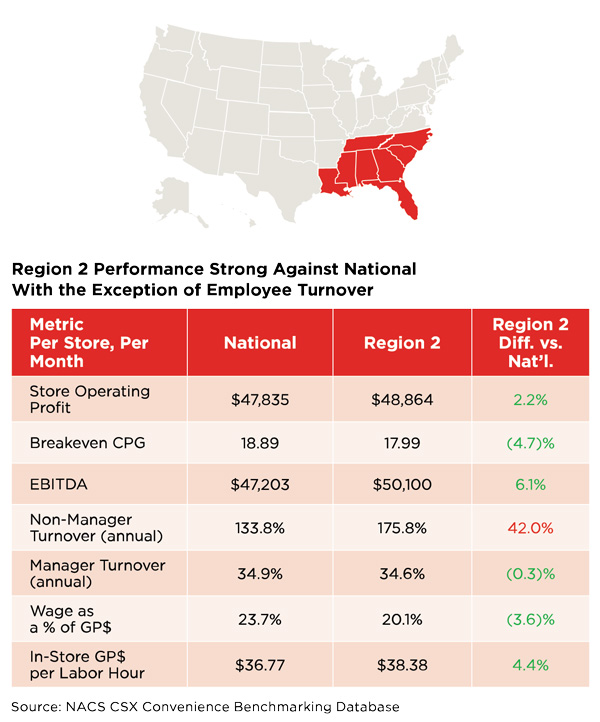
The seven states in the southeastern United States that make up Region 2 contribute 23.8% (35,742 stores) of the convenience stores in the country. Region 2’s financial performance measures were slightly stronger than the national average in 2022, except for non-manager turnover, which was much higher than the national average and the highest of any NACS region.
“As we all know, in the region we have a hard time with labor,” said Kevin Hill, senior manager of financial planning and analysis at Atlanta, Georgia-based RaceTrac, adding that non-manager turnover was up YoY by 6 points.
“Overall, Region 2 unemployment was not dramatically different from the national average, although it was slightly below for most of 2022,” said Hill, emphasizing that Region 2 is a tough labor environment for operators.
The labor force participation rate (58.9%) was also lower than the national average of 61.9% in 2022. Hill noted that the rate has not, and might not, recover to pre-pandemic levels. This could be due to the “Great Reevaluation” and people leaving the workforce entirely.
“In Region 2, there are a lot of retirees and they could be pushing our labor force participation rate down,” suggested Hill.
Foodservice sales in the region are behind the national average but growing quickly. All categories of foodservice increased YoY except frozen dispensed, at $904 per store, per month, a 5.1% decline from the region’s performance last year and far below the national average of almost $4,000.
Prepared food registered a very strong 18.5% YoY increase to $22,110 per store, per month, while cold dispensed racked up a 17.4% YoY increase. “Perhaps as a region we’re starting to provide enhanced prepared food offerings and we’re catching up to the national numbers,” Hill said.
“We have a lot of opportunity in this region, if we are able to solve our labor challenges, control operating expenses and grow inside profitability,” he concluded.
Region 3
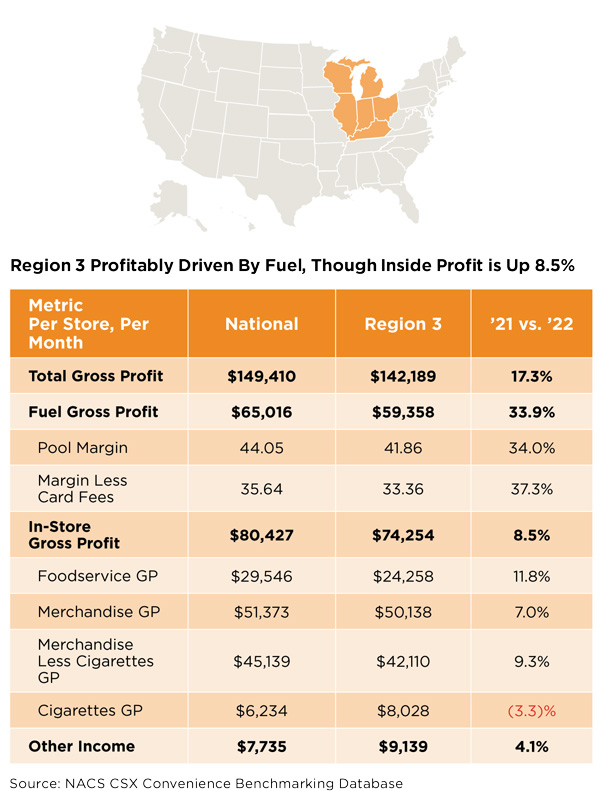
Region 3 contributes 23,516 stores to the U.S. total, or 15.7%, and includes the states of Illinois, Indiana, Kentucky, Michigan, Ohio and Wisconsin.
Region 3 store operating profit was 8.7% lower than the national average, at $43,659 per store, per month. However, that’s up from $34,418 in 2021.
“Even though lower than the national average, store operating profit did improve by nearly 27% year over year,” shared Ruth Ann Lilly, senior vice president of merchandising and marketing, GPM Investments, during her presentation of Region 3 metrics.
Compared to neighboring regions, Region 3 did better in employee metrics than in financial ones. It had lower non-manager turnover (71.2%) than all but Region 5 and lower manager turnover (28.6%) than all but Regions 1 and 5. “Non-manager turnover continues to be a metric we can be proud of, improving year over year 2.5 points,” said Lilly.
While store operating profit was slightly lower than the national average, it and EBITDA surged nearly 30% compared with 2021. On a year-over-year basis, key performance measures were largely positive for Region 3.
Total sales in Region 3 increased primarily as a result of increased fuel sales—driven primarily by price, which was up 35.4%. Merchandise sales were also up 4.2% YoY. Total gross profit was up 17.3% YoY.
Inside gross profit was $74,254 per store, per month. This was higher than all other regions with the exception of Region 1.
“Region 3 is really known for community-oriented stores and high-growth foodservice, and that showed up in the data. We had sales and gross profit growth in both fuel and inside categories, but the strongest growth came from foodservice categories, which were up in sales 18.7% year over,” said Lilly. Commissary is a star foodservice category in Region 3, with per store, per month sales of $11,420, up 14.6% YoY and more than $5,000 per store, per month higher than the national average.
Region 4
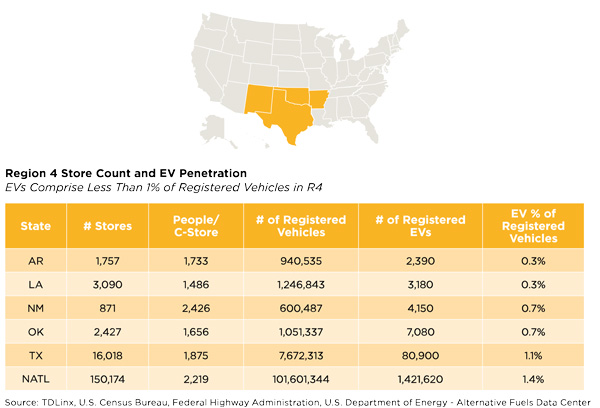
Region 4 includes Arkansas, Louisiana, New Mexico, Oklahoma and Texas. The region has the third-highest store count of the six NACS regions, with over 24,000 sites. More than 16,000 of these are found in Texas.
The region boasts dense store counts, with Louisiana leading the way at one store for every 1,486 people, compared to the national average of one store per 2,219 people. In addition, it has high penetration of QSRs, providing additional competition, shared Abraham Albert, vice president finance and strategic planning, 7-Eleven Inc.
The average operating profit per store, per month for Region 4 was $31,987 last year—33.1% lower than the national average. EBIDTA per store, per month was $21,261, which was 55% lower than the rest of the country.
The numbers look a lot better, though, when compared to 2021 performance. Operating profit went from $24,035 per store, per month, to $31,987. “This is where you start to see really good results. Anytime something is up 33%, that is a heck of a run,” said Albert. EBITDA per store, per month was up 28.7%.
Turnover increased for both employees and managers in 2022. Region 4 manager turnover was 29.6%, up 8.9 points, while non-manager turnover was 163.0%, up 4.4 points.
“Management turnover is one area that continues to be a challenge,” said Albert.
Access to supply and relatively low taxes leads Region 4 to, historically, have lower fuel prices than average. In 2022, Region 4 reported an average per gallon price of $3.75, the lowest in the nation.
A metric introduced last year by NACS is the number of EVs per state. EVs have made slow progress in Region 4. In Arkansas and Louisiana, only 0.3% of registered vehicles are EVs. In Texas, the home of Tesla, 1.1% of registered vehicles are EVs. For comparison, 4% of the vehicles in California are electric.
“EV isn’t something we should just ignore. It will absolutely change and will continue to evolve. It is an evolution not a revolution,” said Albert.
Average inside sales per store, per month in Region 4 last year were $170,810—up 9.5% from the region’s 2021 performance. Foodservice averaged $33,230 per store, per month in 2022, up 16.3% YoY. Transactions were up in Region 4 last year at 28,328, up by 0.2%.
Region 5

Region 5 has 13,127 stores, or 8.7% of the U.S. total. Its 10 states extend from Missouri to Montana.
“On a year-over-year basis, key performance measures are largely positive for Region 5,” said Mike Wilson, COO of Cubby’s, which has 41 stores and is based on Omaha, Nebraska.
Given the region’s rural nature, it’s no surprise that stores do less business, with an average store operating profit of $35,341 per store, per month, 26.1% less than the national average. However, that is a 20.5% increase from 2021. EBITDA increased 17.6%.
Region 5 had a greater increase in inside transactions than any other region, moving to 22,747 per store, per month, an 8.0% increase. Average basket size increased just 0.9%, leading Wilson to speculate that in this region inflation led shoppers to buy less per trip but to return more frequently.
Another very positive result is non-manager turnover, at 65.7%, 68.1 points below the national average. Manager turnover, at 27.2%, is 7.7 points better than nationally.
“We believe in having engaged employees who understand the ‘why’ behind what we’re doing. I’m a firm believer that it’s our engaged employees that got us through the pandemic and continue to drive us and let us thrive,” said Wilson. He added that he records a podcast with Cubby’s president Delone Wilson that is sent to all employees “where we explain the ‘why.’”
One unusual feature of the region is the strong sales of milk, which ranks No. 7 in terms of in-store categories at $2,874 per store, per month, up 12.1%.
Despite the generally positive outcomes, units sold declined across most categories. Region 5 had the steepest units sold declines in the nation in cigarettes (a drop of 9.0%), packaged beverages (a drop of 3.9%), and candy (a 3.8% drop). Overall units sold fell 2.5%, the biggest drop in the country.
Region 6

Small stores, big baskets, better fuels: That’s the story for Region 6, which is anchored by California and includes eight other states.
Small stores: The average store size in Region 6 is 2,460 square feet, by far the smallest of any region and a full 1,000 feet smaller than the average store in Region 2, which has the second-smallest stores.
“Most of our stores are in high-density metropolitan areas and they don’t necessarily have a lot of land to grow and expand,” said Petros Keshishyan, senior director of financial planning and analysis at United Pacific, during his presentation of Region 6 data.
That small store size explains many of the region’s anomalies, including a relative lack of foodservice dollars. With fewer kitchens, Region 6 averaged $20,589 per store, per month in foodservice sales, compared to a national average of $56,491. However, foodservice sales were up a healthy 13.3%.
Another anomaly is that direct store operating expenses (DSOE) are much lower than the rest of the country, although the DSOE of $61,518 represented a 13.6% increase from 2021.
Big baskets: Declining inside transactions (11,979 per store, per month, down 2.2%) weren’t completely offset by a 9.2% increase in basket size to $12.79. The average basket size nationally is $7.52, meaning the region’s baskets are more than $5 larger than those nationally. Inside sales overall grew 6.7%, meaning they fell below the rate of inflation.
Beer and wine sales in Region 6 substantially outpaced the national averages, at least partly explaining why basket size is so much larger than the national average. Wine was a particular bright spot, improving 12.8% in sales to an average of $2,067 per store, per month. Region 6 is the only region with wine as a top 10 in-store category.
Better fuels: “The headline in Region 6 is fuel,” said Keshishyin. Despite being home to 53% of the nation’s EVs, the region’s stores sold more fuel than the national average, with a 2.3% increase in gallon sales and a 32% increase in price. That led to store operating profit increasing 29.1% year over year.
“There’s a path to making profits but it may not be the same in every region, and this was evident in Region 6,” Keshishyan concluded.